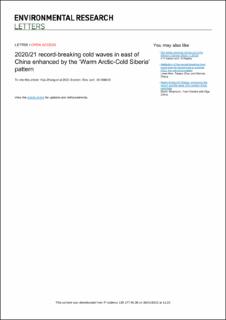| dc.contributor.author | Zhang, Yijia | |
| dc.contributor.author | Yin, Zhicong | |
| dc.contributor.author | Wang, Huijun | |
| dc.contributor.author | He, Shengping | |
| dc.date.accessioned | 2022-02-16T10:33:49Z | |
| dc.date.available | 2022-02-16T10:33:49Z | |
| dc.date.created | 2021-09-27T12:36:30Z | |
| dc.date.issued | 2021 | |
| dc.identifier.issn | 1748-9326 | |
| dc.identifier.uri | https://hdl.handle.net/11250/2979313 | |
| dc.description.abstract | Extreme cold waves frequently occur in east of China that dramatically endanger ecological agriculture, power infrastructure and human life. In this study, we found that the 'Warm Arctic-Cold Siberia' pattern (WACS) significantly enhanced cold waves in east of China according to daily composites from 1979 to 2018. During the winter 2020/21, a record-breaking cold wave broke out following a noticeable WACS phenomenon and induced the record-low surface air temperature at 60 meteorological stations since they were established (nearly 60 years). On 3 January 2021, the difference in temperature anomaly between the Barents–Kara Sea and Siberia reached 20 °C, the peak of winter 2020/21. With a shrinking meridional temperature gradient, the atmospheric baroclinicity weakened correspondingly. The accompanying atmospheric anomalies, i.e. the persistent Ural Blocking High and Baikal deep trough effectively transported stronger cold air than the sole impact from Arctic warming. After 4 d, the east of China experienced a severe surface air temperature decrease of more than 8 °C, covering an area of 2500 000 km2. During the same winter, a record-breaking warm event occurred in February 2021, and the 'Cold Arctic-Warm Eurasia' pattern also appeared as a precursory signal. Furthermore, on the interannual scale, the connection between winter-mean temperature anomalies in east of China and the WACS pattern also existed and even performed more strongly in both observations and simulation data of CMIP6. | en_US |
| dc.language.iso | eng | en_US |
| dc.publisher | IOP Publishing | en_US |
| dc.rights | Navngivelse 4.0 Internasjonal | * |
| dc.rights.uri | http://creativecommons.org/licenses/by/4.0/deed.no | * |
| dc.title | 2020/21 record-breaking cold waves in east of China enhanced by the ‘Warm Arctic-Cold Siberia’ pattern | en_US |
| dc.type | Journal article | en_US |
| dc.type | Peer reviewed | en_US |
| dc.description.version | publishedVersion | en_US |
| dc.rights.holder | Copyright 2021 The Author(s) | en_US |
| dc.source.articlenumber | 094040 | en_US |
| cristin.ispublished | true | |
| cristin.fulltext | original | |
| cristin.qualitycode | 2 | |
| dc.identifier.doi | 10.1088/1748-9326/ac1f46 | |
| dc.identifier.cristin | 1939022 | |
| dc.source.journal | Environmental Research Letters | en_US |
| dc.identifier.citation | Environmental Research Letters. 2021, 16 (9), 094040. | en_US |
| dc.source.volume | 16 | en_US |
| dc.source.issue | 9 | en_US |

